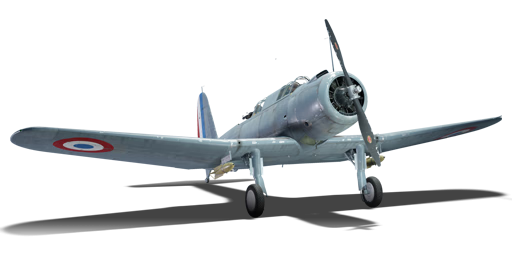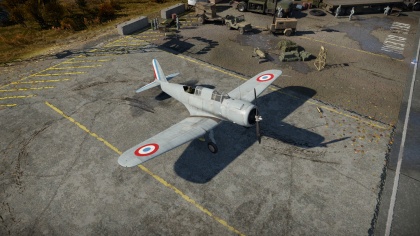V-156-F
Contents
| This page is about the French bomber V-156-F. For the British version, see V-156-B1. |
Description
The V-156-F is a rank I French bomber
with a battle rating of 1.3 (AB/SB) and 1.0 (RB). It was introduced in Update 1.75 "La Résistance".
The SB2U-2 was developed in the early 1930s and was sold to the French as a V-156-F. This aircraft served on the French aircraft carrier Béarn, however at the outbreak of the war, the carrier was deemed too slow for service and both squadrons of V-156-F aircraft were transferred to land-based duty. The V-156-F was used continually until the French Armistice.
This aircraft is a fairly slow aircraft, but sturdy. Built as a dive-bomber, it excels at diving down above a target to release its bombs. The V-156-F is one of the only early aircraft in War Thunder which features dive brakes (key-bound to 'H' by default) to aid in slowing down during a dive, thereby helping prevent the ripping off of the wings in RB and SB. The V-156-F differs from its American siblings (SB2U-2/-3) in that it has additional air brakes mounted on the upper and lower surfaces of the wings which extend 90 degrees to the wing when utilized. Wing mounted machine guns allow for this aircraft to strafe softer ground or water targets while waiting for bombs to reload (AB). The rear-facing dorsal gunner helps to ward off enemy attackers, however it is not a game changer for this aircraft.
General info
Flight performance
Describe how the aircraft behaves in the air. Speed, manoeuvrability, acceleration and allowable loads - these are the most important characteristics of the vehicle.
| Characteristics | Max Speed (km/h at 4,084 m) |
Max altitude (metres) |
Turn time (seconds) |
Rate of climb (metres/second) |
Take-off run (metres) | |||
|---|---|---|---|---|---|---|---|---|
| AB | RB | AB | RB | AB | RB | |||
| Stock | 343 | 328 | 6800 | 23.2 | 24.5 | 4.5 | 4.5 | 300 |
| Upgraded | 380 | 360 | 20.9 | 22.0 | 8.2 | 6.2 | ||
Details
| Features | ||||
|---|---|---|---|---|
| Combat flaps | Take-off flaps | Landing flaps | Air brakes | Arrestor gear |
| X | X | ✓ | ✓ | ✓ |
| Limits | ||||||
|---|---|---|---|---|---|---|
| Wings (km/h) | Gear (km/h) | Flaps (km/h) | Max Static G | |||
| Combat | Take-off | Landing | + | - | ||
| 740 | 440 | N/A | N/A | 700 | ~13 | ~7 |
| Optimal velocities (km/h) | |||
|---|---|---|---|
| Ailerons | Rudder | Elevators | Radiator |
| < 300 | < 350 | < 320 | > 299 |
| Compressor (RB/SB) | ||
|---|---|---|
| Setting 1 | ||
| Optimal altitude | 100% Engine power | WEP Engine power |
| 2,895 m | 750 hp | 825 hp |
Survivability and armour
- 3 mm steel boxes behind the gunner
- Self-sealing fuel tank located behind the pilot
Armaments
Offensive armament
The V-156-F is armed with:
- 2 x 7.5 mm Mle 1923 machine guns, wing-mounted (1,000 rpg = 2,000 total)
Suspended armament
The V-156-F can be outfitted with the following ordnance:
- 2 x 50 kg G.A. MMN. 50 bombs (100 kg total)
- 2 x 100 kg No.1 bombs (200 kg total)
Defensive armament
The V-156-F is defended by:
- 1 x 7.5 mm Mle 1923 machine gun, dorsal turret (750 rpg)
Usage in battles
The V-156-F is a slow aircraft which leads it to having two options. The first is to hug the terrain. While flying to your target of choice (AAA sites, AA Vehicles or bases), fly along the terrain, utilize what hills and valleys there are to fly through. Time on target may be limited before the enemy gets there so line up your bombing run and drop bombs. This aircraft can manoeuvre fairly well, utilizing elevator and rudder controls and a nice turn time (upgraded) of 22 seconds (RB), you can quickly flip this aircraft around and return to ground attacking targets you just flew over.
The second option will be to gain altitude. Going too high will render your bombs ineffective. The idea here is to gain several thousand feet, fly towards your target of choice and then dive on it. During your dive, your aircraft will build up speed, to prevent too much speed build up and control stiffening, reduce your throttle and engage dive brakes (h). This will allow you a controlled descent and the ability to line up your target easier, the unfortunate downside is that now you are slowly moving in a straight line, an easy target for enemy fighters. Once you swoop on your target and release your bombs, engage full throttle and retract dive brakes.
Although this aircraft is slow, it can be utilized to attack fighters if in a pinch. The manoeuvrability of this aircraft along with its slow speed can aid in forcing an attacking enemy to overshoot or underestimate the capabilities of this aircraft.
Manual Engine Control
| MEC elements | ||||||
|---|---|---|---|---|---|---|
| Mixer | Pitch | Radiator | Supercharger | Turbocharger | ||
| Oil | Water | Type | ||||
| Controllable | Controllable Not auto controlled |
Controllable Not auto controlled |
Controllable Not auto controlled |
Separate | Not controllable 1 gear |
Not controllable |
Modules
| Tier | Flight performance | Survivability | Weaponry | ||
|---|---|---|---|---|---|
| I | Fuselage repair | Radiator | Offensive 7 mm | ||
| II | Compressor | Airframe | New 7 mm MGs | 100 GPs | |
| III | Wings repair | Engine | Turret 7 mm | ||
| IV | Engine injection | Cover | New 7 mm MGs (turret) | ||
Pros and cons
Pros:
- Manoeuvrable
- Dual role dive bomber/attacker
- Good diver
- Has air brakes
Cons:
- Large target
- Slow speed
- Weak defensive armament
- Armament is smaller calibre than its American and British counterparts
- Worse payload options than its American and British counterparts (max payload 200 kg)
- Rather long take off run
- Only has landing flaps
- The air brakes are the flaps, meaning that landing flaps cannot be deployed when the airbrakes are, and vice versa
History
Describe the history of the creation and combat usage of the aircraft in more detail than in the introduction. If the historical reference turns out to be too long, take it to a separate article, taking a link to the article about the vehicle and adding a block "/History" (example: https://wiki.warthunder.com/(Vehicle-name)/History) and add a link to it here using the main template. Be sure to reference text and sources by using <ref></ref>, as well as adding them at the end of the article with <references />. This section may also include the vehicle's dev blog entry (if applicable) and the in-game encyclopedia description (under === In-game description ===, also if applicable).
Media
Excellent additions to the article would be video guides, screenshots from the game, and photos.
See also
Links to the articles on the War Thunder Wiki that you think will be useful for the reader, for example:
- reference to the series of the aircraft;
- links to approximate analogues of other nations and research trees.
External links
Paste links to sources and external resources, such as:
- topic on the official game forum;
- encyclopedia page on the aircraft;
- other literature.
| Chance Vought Aircraft | |
|---|---|
| Fighters | |
| Corsair | F4U-1A · F4U-1A (USMC) · F4U-1C · F4U-1D · F4U-4 · F4U-4B · F4U-4B VMF-214 |
| Float planes | O3U-1 · OS2U-1 · OS2U-3 |
| Attackers | AU-1 |
| Bombers | SB2U-2 · SB2U-3 |
| Jet aircraft | |
| Corsair II | A-7D · A-7E · A-7K |
| Crusader | F8U-2 · F-8E |
| Export | V-156-B1 · V-156-F · ▄Corsair F Mk II · F4U-7 · ▄F-8E(FN) |
| Captured | ▅F4U-1A |
| France bombers | |
|---|---|
| Farman | F.222.2 · N.C.223.3 |
| Latécoère | Late 298D |
| Potez | Potez 633 |
| Liore et Olivier | LeO 451 early · LeO 451 late |
| Bloch | M.B.174A-3 · M.B.162 · M.B.175T |
| American | V-156-F · Martin 167-A3 · ▄A-35B · ▄SB2C-5 · B-26C · ▄PBY-5A Late · ▄PB4Y-2 |
| British | Lancaster MR.7 |





